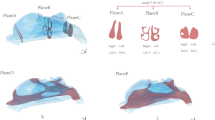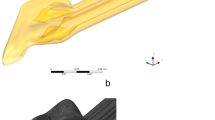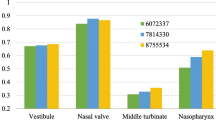Abstract
To study the airflow distribution in human nasal cavity during respiration and the characteristic parameters of nasal structure, three-dimensional, anatomically accurate representations of 30 adult nasal cavity models were reconstructed based on processed tomography images collected from normal people. The airflow fields in nasal cavities were simulated by fluid dynamics with finite element software ANSYS. The results showed that the difference of human nasal cavity structure led to different airflow distribution in the nasal cavities and variation of the main airstream passing through the common nasal meatus. The nasal resistance in the regions of nasal valve and nasal vestibule accounted for more than half of the overall resistance. The characteristic model of nasal cavity was extracted on the basis of characteristic points and dimensions deduced from the original models. It showed that either the geometric structure or the airflow field of the two kinds of models was similar. The characteristic dimensions were the characteristic parameters of nasal cavity that could properly represent the original model in model studies on nasal cavity.
Similar content being viewed by others
References
Uliyanov, Y.P.: Surgical reconstruction of nasal serodynamics. In: Proceedings of 16th World Congress of Otolaryngol Head and Neck Surg., XVI World Congress of Otolaryngol Head and Neck Surg, Sydney, Australia, pp.~1591–1595 (1997)
Liu Y.X., Yu S. and Sun X.Z., (2005). Structure of nasal cavity and characters of airflow. Chin. J. Otorhinolaryngol Head Neck Surg. 40(11): 846–849
Keyhani K., Scherer P.W. and Mozell M.M. (1995). Numerical simulation of airflow in the human nasal cavity. J. Biomech. Eng. 117: 429–441
Hahn I., Scherer P.W. and Mozell M.M. (1993). Velocity profiles measured for airflow through a large scale model of he human nasal cavity. J. Appl. Physiol. 75: 2273–2287
Martonen T.B., Quan L. and Zhang Z., (2002). Flow simulation in the human upper respiratory tract. Cell Biochem. Biophys. 37: 27–36
Subramaniam R.P., Richardson R.B. and Morgan K.T. (1998). Computational fluid dynamics simulations of inspiratory airflow in the human nose and nasopharynx. Inhalation Toxicol. 10: 91–120
Kim S.K. and Chung S.K. (2004). An investigation on airflow in disordered nasal cavity and its corrected models by tomographic PIV. Meas. Sci. Technol. 15: 1090–1096
Reimersdahl Th., Hörschler I. and Gerndt A. (2001). Airflow simulation inside a model of the human nasal cavity in a virtual reality based rhinological operation planning system. Int. Congr. Serg. 1230: 87–92
Hörschler I., Meinke M. and Schröder W. (2003). Numerical simulation of the flow field in a model of the nasal cavity. Comput. Fluids 32: 39–45
Guitong Y., Weiyi C. and Jinbin X. (1999). Biomechanics. Chongqing Press, Chongqing
keyhani K. and Scherer P.W. (1995). Numerical simulation of airflow in the human nasal cavity. J. Biomech. Eng. 117: 429–441
Ulyanov Y.P. (1998). Clinical manifestations the variants of nasal aerodynamics. Otolaryngol Head Neck Surg. 119: 152–153
Author information
Authors and Affiliations
Corresponding author
Additional information
The project was supported by the National Natural Science Foundation of China (10472025; 10672036) and the Natural Science Foundation of Liaoning Province, China (20032109).
The English text was polished by Yunming Chen.
Rights and permissions
About this article
Cite this article
Zhang, J., Liu, Y., Sun, X. et al. Computational fluid dynamics simulations of respiratory airflow in human nasal cavity and its characteristic dimension study. Acta Mech. Sin. 24, 223–228 (2008). https://doi.org/10.1007/s10409-008-0148-z
Received:
Revised:
Accepted:
Published:
Issue Date:
DOI: https://doi.org/10.1007/s10409-008-0148-z




